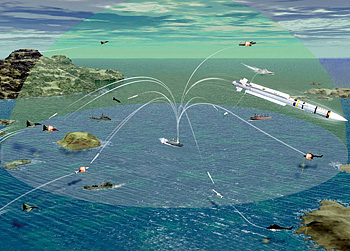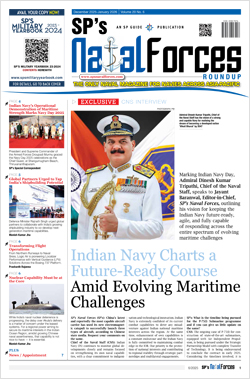INDIAN ARMED FORCES CHIEFS ON OUR RELENTLESS AND FOCUSED PUBLISHING EFFORTS

The insightful articles, inspiring narrations and analytical perspectives presented by the Editorial Team, establish an alluring connect with the reader. My compliments and best wishes to SP Guide Publications.

"Over the past 60 years, the growth of SP Guide Publications has mirrored the rising stature of Indian Navy. Its well-researched and informative magazines on Defence and Aerospace sector have served to shape an educated opinion of our military personnel, policy makers and the public alike. I wish SP's Publication team continued success, fair winds and following seas in all future endeavour!"

Since, its inception in 1964, SP Guide Publications has consistently demonstrated commitment to high-quality journalism in the aerospace and defence sectors, earning a well-deserved reputation as Asia's largest media house in this domain. I wish SP Guide Publications continued success in its pursuit of excellence.
- Global Partners Urged to Tap India's Shipbuilding Potential: Rajnath Singh at Samudra Utkarsh
- All about HAMMER Smart Precision Guided Weapon in India — “BEL-Safran Collaboration”
- India, Germany deepen defence ties as High Defence Committee charts ambitious plan
- G20 Summit: A Sign of Global Fracture
- True strategic autonomy will come only when our code is as indigenous as our hardware: Rajnath Singh
- India–Israel Joint Working Group Meeting on defence cooperation to boost technology sharing and co-development
Technology
Attaining Revolutionary Capability

To further augment its NCW capabilities, the Indian Navy is at an advanced stage of indigenously developing networkcentric operation system at a cost of $1 billion, eventually to be networked with the satellite over the next few years
Network-Centric Warfare (NCW) has emerged as a vital and revolutionary capability for military operations. Its potential and dynamic applications has earned immediate global recognition, prompting all leading military forces of the world planning for its development and adoption, to meet the security challenges that exist in their respective areas of responsibilities. The US and especially the US Navy has stolen a march in this spectrum by developing a NCW capability. NCW is based on using information technology, computers, high-speed data links, and networking software to connect navy ships, aircraft, and shore installations into highly integrated local area network (LAN) and wide area network (WAN) networks. This would also greatly improve naval capabilities and affect major changes in naval tactics, doctrine, and organisation. Within these networks, all platforms share large amounts of critical information seamlessly on real-time basis. The programmes for implementing NCW include the cooperative engagement capability (CEC), the Naval Fires Network (NFN) and the IT-21 programme. A related programme is the Navy-Marine Corps Intranet (NMCI).
CEC Concept: CEC is a sensor network with integrated fire control that provides a means by which data from existing sensor and fire control systems can be combined and distributed to each element of a networked force. It is simple in concept but very complex to develop and implement. There are many factors besides the horizon that can affect radar detection. These include the radar cross-section of the target itself, radar clutter, atmospherics, closely spaced targets, jamming, and terrain screening. Thus individual radars sometimes have difficulty maintaining continuous and accurate tracks. CEC nets sensors together so that brief periods of detection on a target can be combined throughout the network to produce a single continuous track. As the resulting composite tracks are available throughout the network, many units get track data they never would have received otherwise, and all combatants can participate in a coordinated identification and engagement process. CEC system uses antennas and data processors to link ships and aircraft operating in a specific area into a single, integrated air-defense network in which the radar data collected by each platform is transmitted on a real-time basis to the other units in the network. each unit in the CEC network carries out data fusion with data received from the other units. As a result, units in the network share a common, composite and real-time air-defence picture. This will permit a ship to use radar targeting data gathered by other ships and aircraft for shooting down anti-ship missiles that the ship cannot see. It will also permit air-defence missiles fired by one ship to be guided by other ships or aircraft. CEC will also obviate the necessity of inducting additional weapons and radars as it will synergise the existing resources, using identical algorithms, to the optimum. CEC was essentially designed to counter threat emanating from cruise missiles, especially while operating in littoral waters. The backbone of CEC is an efficient communications system with vastly improved bandwidth, electronic countermeasures and advantages offered by the GPS.
Naval Fires Network (NFN): The NFN uses commercial off-the-shelf (COTS) IT technologies to link naval forces operating in an area into a single real-time targeting network for coordinating gun and missile fire to attack surface and land targets, particularly time-critical targets, in support of friendly forces ashore. NFN allows sensor data and other intelligence information to be rapidly converted to accurate targeting information for PGMs. It implies that after acquiring target information from a UAV, transmit this information into a network and get it converted into ballistic data to engage the target.
IT-21: IT-21 which stands for IT for the 21st century, is the US Navy’s investment strategy for procuring the desktop computers, data links and networking software needed to establish an intranet for transmitting tactical and administrative data within and between navy ships. IT-21 is the US Navy’s network at sea installed across the fleet. It delivers the first integrated network that brings local and wide-area connectivity and applications to fleet users. The objective is to provide the fleet with a modern communications capability that utilises COTS technologies.
Navy-Marine Corps Intranet (NMCI): The NMCI is a corporate-style intranet that would link the US Navy and Marine Corps shore installations in much the same way as IT-21 effort will link together the US Navy ships. The NMCI brings integrated network capability ashore and along with IT-21 enables day-to-day work of the fleet. In addition to the ships, a large percentage of all the navy’s piers are connected directly to the Internet.





